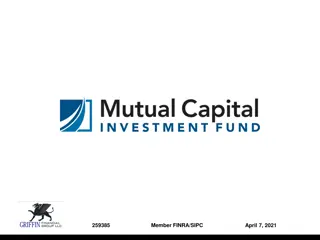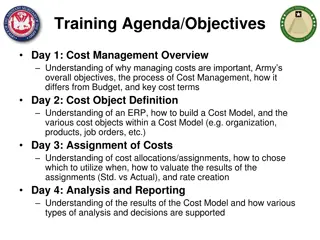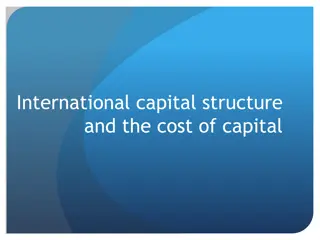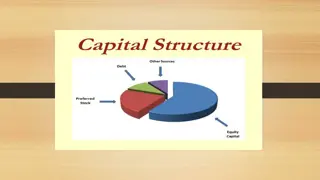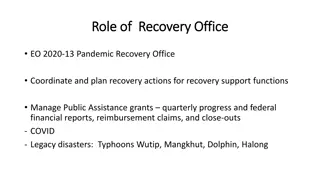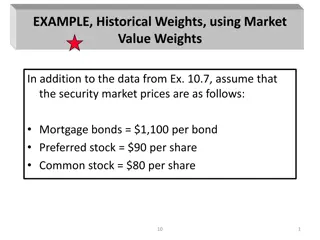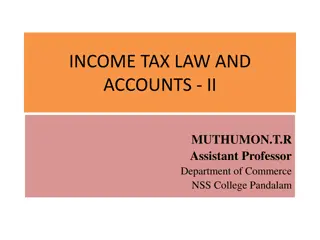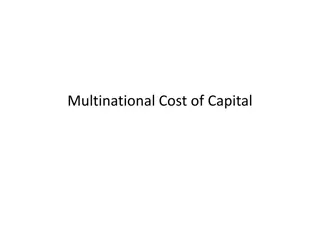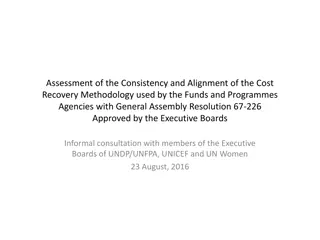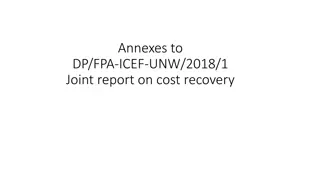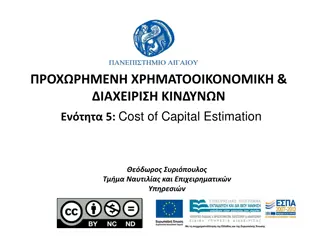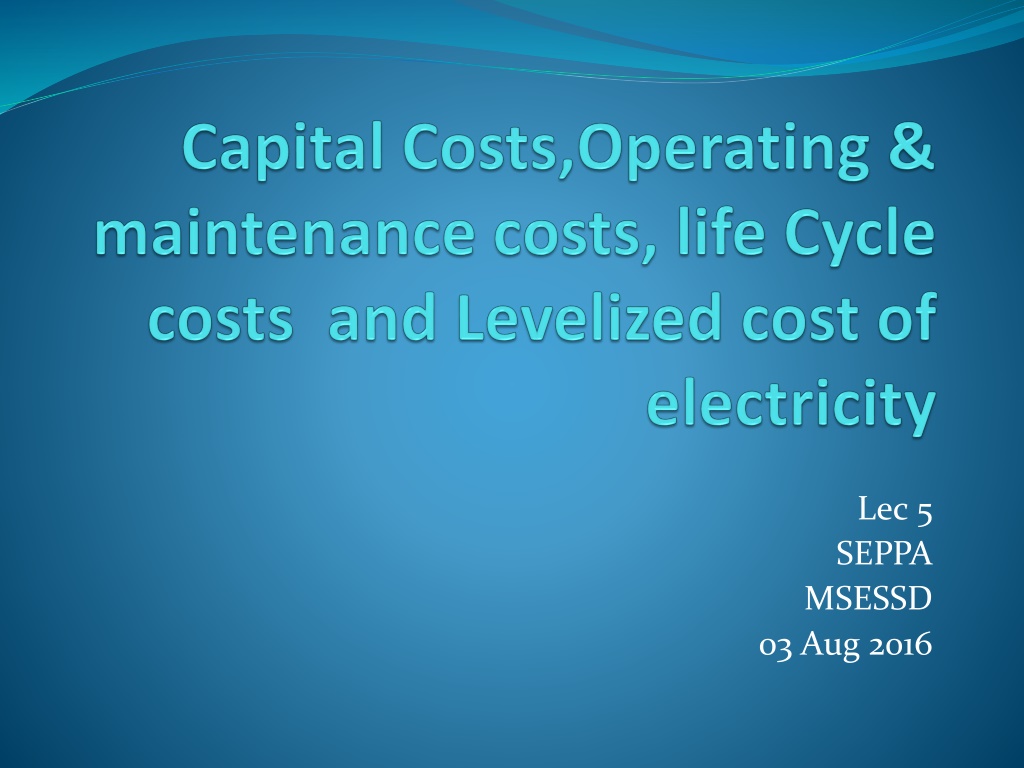
Capitalized Equivalent Method in Project Evaluation
Explore the Capitalized Equivalent Method (CEM) for project evaluation, including its application for projects with perpetual life or long planning horizons. Learn how to calculate project value and Net Present Value (NPV) over infinite periods. Discover the significance of Mutually Exclusive Projects and Annual Equivalent Value Analysis in investment decisions.
Uploaded on | 0 Views
Download Presentation

Please find below an Image/Link to download the presentation.
The content on the website is provided AS IS for your information and personal use only. It may not be sold, licensed, or shared on other websites without obtaining consent from the author. If you encounter any issues during the download, it is possible that the publisher has removed the file from their server.
You are allowed to download the files provided on this website for personal or commercial use, subject to the condition that they are used lawfully. All files are the property of their respective owners.
The content on the website is provided AS IS for your information and personal use only. It may not be sold, licensed, or shared on other websites without obtaining consent from the author.
E N D
Presentation Transcript
Lec 5 SEPPA MSESSD 03 Aug 2016
Capitalized Equivalent Method = + / ) 1 + / 1 = N N lim ( / , , ) lim [(( = 1 ) i 1 ( ) ] P A i N , , i i i N ( N = ) ( / ) / PV i A P A i N A i 3/21/2025 2
Capitalized Equivalent Method Another method of PV criterion is useful when the life of project is perpetual or planning horizon is very long. Perpetual Service life PV = A/i 3/21/2025 3
Capitalized Equivalent Method The process of calculating PV cost for infinite period is called capitalization of project cost. The cost is known as the Capitalized cost i.e. the amount of money to be invested now to get a certain return 'A' at the end of each and every year forever. A i = PV 3/21/2025 4
Capitalized Equivalent Method A hydropower project is of 50 years life. An entrepreneur spent $800,000 (not considering time value of money) during the last 10 years. We have to compute the project value (worth) using different interest rates. (a) If the entrepreneur s MARR is 8% compute NPV with 50 year service life and infinity. (b) Repeat the same at 12% MARR and see the difference. 3/21/2025 5
Types of Projects Mutually exclusive projects are those projects, if you accept one project, you have to exclude other project. For service projects, we use the NPV of costs and choose the project which has the least negative NPV. For revenue projects, we use NPV of revenues and choose the project which ahs the highest NPV. 3/21/2025 6
Annual Equivalent Value Analysis The annual equivalent value (AE) criterion is a basis for measuring investment value by determining equal payments on an annual basis. First, we have to find the NPV of the project and then convert it to equal annual payments. 3/21/2025 7
Annual Equivalent Value (AEV) AE(i) =PV(i)(A/P,i,n) If AE>0, accept the project If AE =0, remain indifferent If AE <0, reject the project 3/21/2025 8
Benefits of AE analysis 1.Consistency of report format. Financial and engineering managers may prefer to work on yearly costs rather than overall costs. 2.Need for unit costs. In many situations, project must be broken down into unit costs for comparison and ease. 3.Unequal project lives. Comparing projects with unequal service lives is complicated in calculations, but using AE analysis, this problem can be easily solved. 3/21/2025 9
Operating Costs and Capital Costs Operating costs are incurred by the operations of the plant or factory. Capital costs are incurred only one time in the project life, where operating costs incur annually. The annual equivalent of the capital cost is capital recovery cost 'CR'. CR = P(A/P,i,n) - S(A/F,i,n) 3/21/2025 10
Operating Costs and Capital Costs (A/F, i, n)=(A/P, i, N) I CR(i) =(i-S)(A/P,i, N) +iS 3/21/2025 11
Life Cycle Cost (LCC) If a project investment cost is P with the service life of n period. The annual operating cost is Ai . The life cycle cost (LCC) is LCC = Capital cost + operating cost n + = ( / , , ) A P A i n LCC P i = 1 n 3/21/2025 12
Annualized Life Cycle Cost (ALCC) Sometime in the big investment project, we have to spread the capital cost for the entire service period, in order to minimize the the lumpy financial burden, then we have to calculate ALCC. ALCC = annual capital cost + annual operating cost ALCC = annual capital cost + annual operating cost 3/21/2025 13
Annualized Life Cycle Cost (ALCC) ALCC =LCC (A/P, I,n) 3/21/2025 14
Selection of technology (class exercise) For an average urban household in Nepal, the monthly requirements of fuels are 17 liters of kerosene, 10 Kg of LPG and 100 kWh of electricity for cooking purposes. The cost of cooking stoves and their service lives are as follows: Kerosene stove LPG stove Electric hotplates Costs for 2: NR 500 3,000 (with 2 burners) 4,000 (with 2 plates) Life: 5 years Life: 10 years Life: 10 years
Levelized cost of electricity (LCOE) Where Lcoe Capex Opex levelized cost of electricity in NR/kWh Capital cost (expenditure) in NR Annual Operating and maintenance cost (expenditure) in NR Discount rate Electricity generated in year i (kWh) Service life of the plant in years R Ei N




